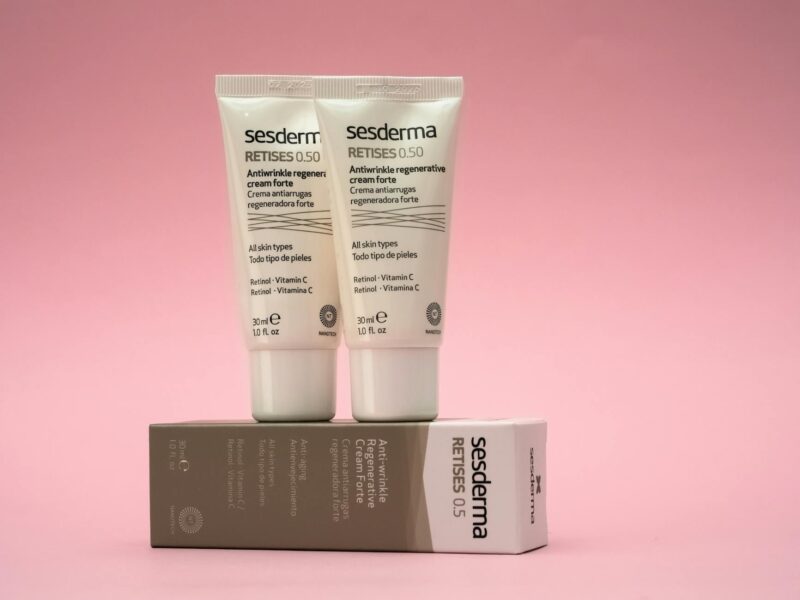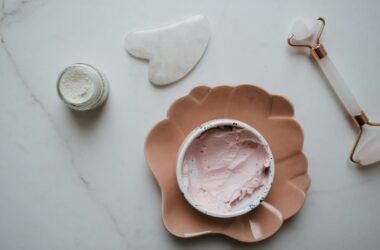Azelaic acid is a skincare superstar and a wonder ingredient for acne woes. But can you use it during the day? Here’s my answer!
Can You Use Azelaic Acid During the Day?
You can use Azelaic Acid during the day, but it’s not recommended. Azelaic Acid is a product that helps with cell turnover, and it works best when your skin is clean and free of makeup.
If you use Azelaic Acid every day, you could end up burning your skin.
The best time to use Azelaic Acid is at night before bed. Make sure your skin is clean and free of makeup.
Wash your face with a mild cleanser and pat dry with a towel. Apply Azelaic Acid to areas where acne or redness occurs.
How Often Should I Apply Azelaic Acid?
Azelaic acid is best applied to the skin once a day. Apply it at night, after you have removed all makeup and cleansed your skin.
Wash your hands before applying azelaic acid to ensure that you do not contaminate the product.
Cover the entire area that needs treatment with a thin layer of azelaic acid, then leave it on for 15 minutes.
You can then apply your moisturizer or other topical products.
Azelaic acid is recommended for use every day for 12 weeks, then as needed to maintain results.
Many people like to apply azelaic acid in the morning after cleansing because it has a mild exfoliating effect that helps remove dead skin cells and helps open pores to allow topical skincare products to penetrate more effectively.
Azelaic acid can also be used once or twice a week as an overnight peel.
You can apply azelaic acid around the eyes, but be careful when applying it under the eyes.
If you have dark circles under your eyes, use one of our eye creams instead, as they are specially formulated for around the eyes.
Can You Use Azelaic Acid Under Make-up?
No, you should not apply any azelaic acid products under your makeup. Azelaic acid is an acid, and it can cause serious burning on sensitive skin if you choose to apply it this way.
This is because it will be able to penetrate the skin better and deeper when applied without obstruction or barrier, giving the acid a much larger effect area in the process.
This can cause skin irritation and even more breakouts than you had before using the product.
Instead of using it under make-up, opt for applying the cream to your face directly after washing and drying your face off.
Letting your face dry completely before applying makes sure that there is nothing wet on your face to interfere with the absorption of azelaic acid under the skin level.
Can You Use Acne Products With Azelaic Acid?
Yes, you can. Acne products that contain azelaic acid work by killing the bacteria that cause pimples.
The substance works by stopping the growth of the bacteria and also helping to prevent new outbreaks of acne.
Acne products with azelaic acid are usually formulated as a cream or lotion and can be applied to pimples directly.
It is also often used in conjunction with benzoyl peroxide, which helps to reduce inflammation, redness and oiliness resulting from acne breakouts.
Is Azelaic Acid Safe for Acne?
According to the National Institutes of Health, topical azelaic acid is safe for use on acne and rosacea.
While it can cause side effects such as stinging and skin irritation, this is not necessarily a sign of an allergic reaction.
However, if you experience severe irritation after applying azelaic acid, consult your physician immediately.
Will Azelaic Acid Work for Blackheads and Clogged Pores?
As a natural skincare ingredient that can help unclog pores and treat acne, azelaic acid is frequently used in products that aim to clear blackheads.
It’s also sometimes used to fade dark marks left behind by overactive sebaceous glands.
But azelaic acid isn’t the best option for everyone, and it might not be the best choice for your particular case of blackheads and clogged pores.
What SPF Should Your Sunscreen Have if You’re Using Azelaic Acid?
If you are using a retinoid like azelaic acid that makes your skin more sensitive to sun exposure, dermatologists recommend using at least an SPF 30 daily moisturizer or a foundation with an SPF 30 or higher during the day, and an SPF 45 or higher at night.
If you’re trying to manage acne breakouts, here’s a breakdown of what level of protection each rating on sunscreen bottles means:
SPF 2-14
Minimal protection from UVB rays. These products provide only minimal protection from sunburn and do not protect against UVA rays.
SPF 15-29
Minimal to low protection from both UVB and UVA rays. An SPF 15 does not protect as well as an SPF 30
How Long Does It Take for Your Skin to Heal With Azelaic Acid?
The healing time of your skin will vary from person to person. Some people can see a reduction in redness and inflammation in as little as two weeks, while others may experience the full six months or more before they start to see results.
However, once your acne clears up, you’ll need to continue treatment with azelaic acid or other topical products indefinitely to prevent its return.
Ask your doctor about maintenance requirements after your initial treatment.
Is Azelaic Acid Safe if You’re Pregnant or Breastfeeding?
The Food and Drug Administration (FDA) has given Azelaic Acid a pregnancy Category C rating, meaning there’s no proven risk to an unborn baby but that some animal studies have shown harm.
The FDA notes on its website that azelaic acid may be absorbed through the skin and cause birth defects in pregnant women.
Some women who take the medication while pregnant experience miscarriage or stillbirths, according to Drugs.com.
Do Products With Azelaic Acid Work Better Than Products Without It?
Anecdotal evidence suggests products with azelaic acid (AzA) work better than products without it, but scientific research doesn’t show that.
The few studies that do exist indicate AzA might be more effective in treating mild-to-moderate inflammatory acne.
To find out if a product works for your skin, you need to try it yourself.
Some people say they notice a difference after just a few weeks of use, but others see no improvement at all.
If your skin doesn’t improve within six months, it’s time to try something else.
Does Azelaic Acid Cause Breakout?
It might be possible that azelaic acid can cause a breakout. However, the usual breakouts that you get from an acne treatment are not caused by azelaic acid itself.
Azelaic acid is used for treating mild to moderate rosacea, which is a skin condition that causes facial redness, pimples and pustules on the face.
This medication is widely available in over-the-counter formulations and prescription medications as well.
It is also used as an acne treatment in mild cases of acne and can be used along with other treatments like retinoids or antibiotics.
The main reason why azelaic acid causes a breakout is that it dries out the skin.
This drying effect can bring some temporary breakouts or irritation, which are not caused by the azelaic acid itself, but by your skin adjusting to this new treatment regime.
The usual breakouts that you get from an acne treatment are usually caused by harsh cleansers or exfoliators that use alcohol or other potentially irritating ingredients.
What Is the Concentration of Azelaic Acid in Skin Care Products?
In general, the concentration of azelaic acid in skincare products is between 0.5% and 20%.
The concentration of azelaic acid in skincare products can reach up to 20%.
The higher the concentration, the greater the ability to treat acne.
However, its ability to treat uneven pigmentation will be weakened.
Can Taking Azelaic Acid Affect My Birth Control Pills?
Trying to prevent pregnancy while taking Azelaic Acid isn’t recommended. This is because Azelaic Acid may also inhibit enzymes in the liver that metabolize hormonal contraceptives.
This means that the contraceptive may not work as well as expected or maybe ineffective.
If you are taking Azelaic Acid, use a non-hormonal form of birth control such as condoms.
Anecdotally, many acne.org members say that their hormonal birth control is less effective when they’re also using Azelaic Acid (AzA).
AzA is an antioxidant that helps fade post-inflammatory hyperpigmentation (PIH).
However, there is no research to confirm this experience.
How to Use Azelaic Acid Safely
Tens of thousands of people have used azelaic acid to clear their mild to moderate acne.
But if you are not careful with your azelaic acid use, you could end up burning your sensitive skin or even developing rosacea.
Here are tips that will help you use azelaic acid safely:
1. Start with a low concentration
Azelaic acid comes in many different formulations.
The lower the concentration of an active ingredient, the less potent it will be for treating your acne.
So when you first start using azelaic acid, pick a formulation that has only 10 percent active ingredient (such as Finacea).
You may need to start out with a 5 percent formulation (Finacea Gel), but if it does not control your acne, consider switching to something more severe.
2. Never apply azelaic acid to broken skin
Doing so could result in scarring or other disfigurements.
Use a protective cream whenever possible, such as petroleum jelly or lanolin, to protect your skin before applying azelaic acid.
3. Don’t wear makeup while using azelaic acid
The makeup might contain ingredients that could interact with azelaic acid and cause a flare-up.
4. Don’t mix azelaic acid with other acne medications
Never apply over-the-counter acne medication after applying azelaic acid because doing so will increase the risk of irritation and burning.
5. Use sun protection
People who use azelaic acid should always use a strong sunscreen that contains at least SPF 30 to protect their skin from sun damage, which can lead to additional skin problems such as wrinkles and cancer.
6. Apply directly on your skin
The best way to apply azelaic acid is directly on the skin because this allows it to penetrate more quickly into your pores.
You can mix it with other medication or put it on top of your favorite acne cream or moisturizer if you want, but applying it directly onto your face results in faster results.
Final Thoughts
If you’re happy with the results you’re getting from using azelaic acid and it’s not aggravating any known skin conditions or allergies, then you can use azelaic acid during the day.







